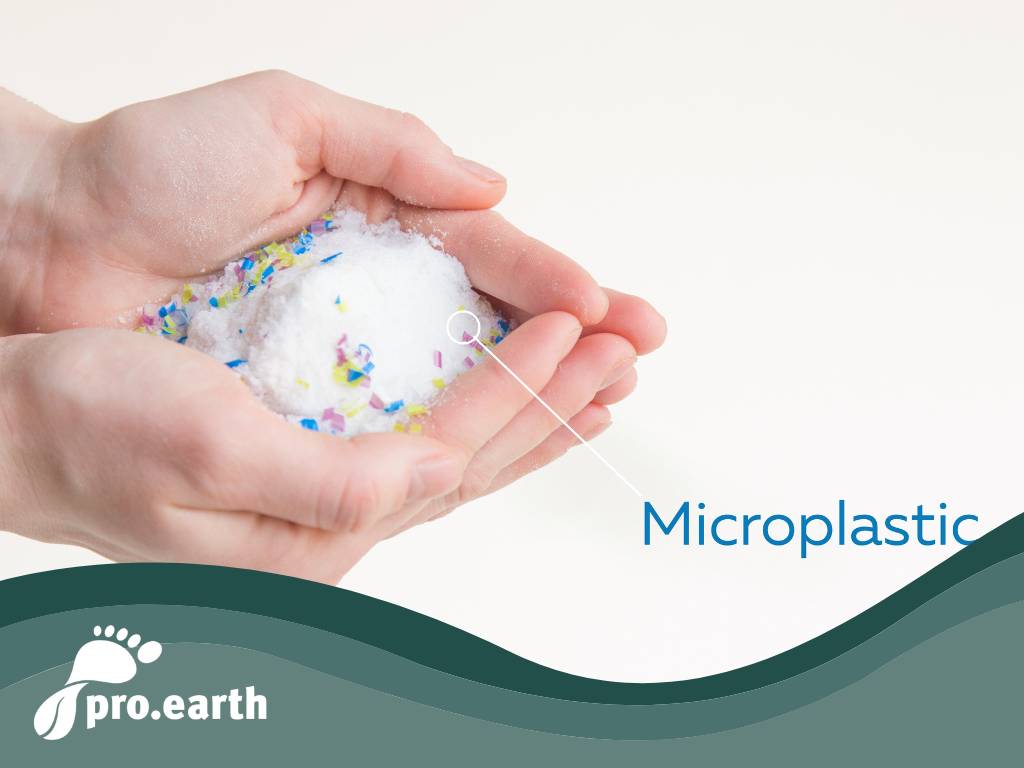What exactly are microplastics?

Plastic hardly ever decomposes completely, but breaks down into smaller and smaller particles. Solid and insoluble synthetic polymers (plastics) that are smaller than 5 mm are referred to as microplastics.
Types of microplastics
A distinction is made between primary and secondary microplastics.
Primary microplastics
It fulfills a specific purpose and comprises so-called plastic pellets that are produced by the industry for further processing. Fine plastic granules and liquid plastic are used in cosmetics production. They can be found in scrubs or as massage beads in shower gels, for example, but also in liquid form as a binding agent. It is also used in paints, but also in fertilizers or in the construction of artificial turf.
Secondary microplastics
This is caused by decay, for example due to solar radiation, wind and waves and/or abrasion. These include
- Washing textiles
- Up to 500,000 microplastic particles are produced per wash cycle! (A fleece jacket, for example, loses up to 3,000 particles)
- Cannot be filtered out in sewage treatment plants - accumulate both in sewage sludge and in water, which in turn ends up in rivers and oceans and also on our fields
- 35 percent of microplastics in the sea come from fiber abrasion from textile washing
- Tire abrasion
- Chipping of paint
- Cutting insulation material to size
- Littering (careless littering in the environment) and much more
Distribution of microplastics in the environment
Microplastics enter our sewage system via our wastewater and sewers and from there into rivers, lakes and the oceans. When sewage sludge is spread on fields, it ends up in our soil in particular.
Researchers have also been able to detect it in rivers and lakes. In the Danube, for example, more plastic particles than fish larvae were found in some places, and in a study of ten British rivers, scientists from Manchester detected more than half a million plastic particles per square meter of riverbed!
Global fishing also contributes to the problem, particularly through nets (so-called ghost nets) and ropes that are discarded by fishermen in the sea.
The particles are also transported through the air and then washed out again by snow, as a study by the Alfred Wegener Institute (AWI) suggests. Extremely high concentrations were measured in snow samples from Germany, the Swiss Alps and the Arctic. In the meantime, this has been detected everywhere on our planet. On the highest mountains as well as in the eternal ice and the most remote deserts.
There are not yet many studies on microplastics in food, but they have already been detected in salt, mussels and fish.
Magnet for toxins
BUND writes on the subject that microplastics act like a magnet for environmental toxins due to their surface properties and attract them. "These are in the water and accumulate on the plastic surface. Concentrations hundreds of times higher than in seawater can be measured here. The plastics and pollutants are then absorbed by marine organisms: Microplastics have been detected in seals, fish, mussels and smaller organisms that ingest them passively or with their food. These pollutants can be released again in the gastrointestinal tract and have an impact on the organism," BUND continues.
Plastic particles in the human body
Not only that, we also have it in our bodies. Microplastics have been detected in human and animal blood. And also in breast milk. Whether it can cross the blood-brain barrier has not yet been scientifically proven. Quarks writes that "However, the Federal Institute for Risk Assessment (BfR) in Berlin assumes that microplastic particles with a diameter of more than two micrometres cannot be absorbed via the intestine or the blood-brain barrier. "
The long-term effects on our bodies have not yet been sufficiently investigated. This is the opinion of both the BfR and the WHO, which also believes that there is no danger from the current concentration of microplastics in drinking water (as of 2019). This is criticized by the Nature and Biodiversity Conservation Union: "The WHO study gives the all-clear too early," says Nadja Ziebarth from the German Federation for Environmental and Nature Conservation (BUND).
"Healthy skin or mucous membranes actually represent a fairly efficient barrier against larger particles," says Hanns Moshammer, Head of the Department of Environmental Hygiene and Environmental Medicine, Center for Public Health at the Medical University of Vienna: "There is still a need for research into the barrier behavior of diseased skin or mucous membranes - for example after injuries and inflammation."






